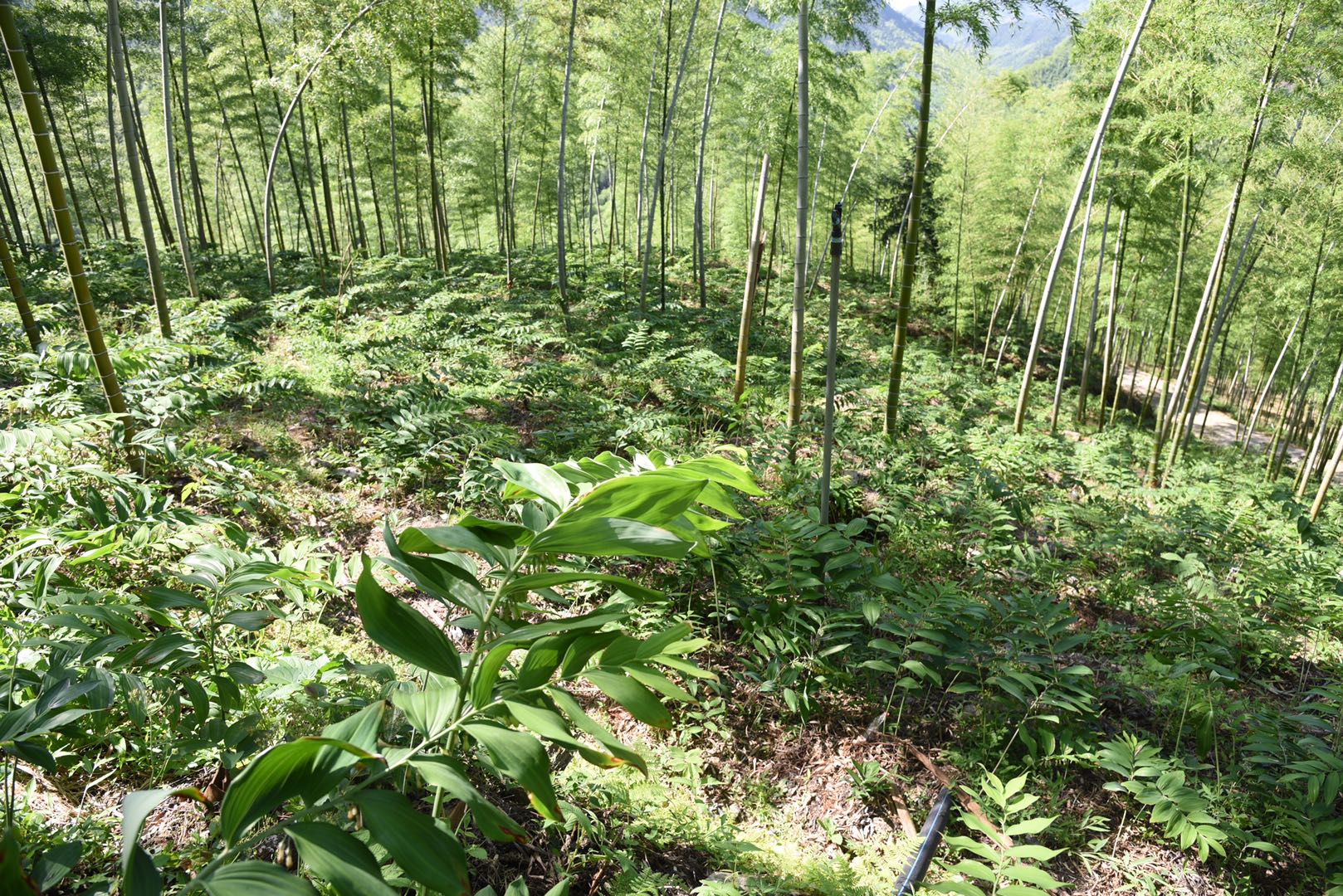 PDF(1965 KB)
PDF(1965 KB)


摘花和打顶措施对毛竹林下多花黄精块茎生物量积累特征的影响
杨清平, 陈双林, 郭子武, 郑进
南京林业大学学报(自然科学版) ›› 2021, Vol. 45 ›› Issue (2) : 165-170.
 PDF(1965 KB)
PDF(1965 KB)
 PDF(1965 KB)
PDF(1965 KB)
摘花和打顶措施对毛竹林下多花黄精块茎生物量积累特征的影响
Responses of tuber biomass accumulation and its allometry to topping and flower plucking measures of Polygonatum cyrtonema grown under Phyllostachys edulis forests
 ,
,
【目的】摘花可减少毛竹林下多花黄精养分在生殖生长上的消耗,打顶能去除顶端生长优势。研究摘花和打顶措施对多花黄精地下块茎生长促进的影响,可为毛竹林下多花黄精高效复合经营提供参考。【方法】以毛竹林下种植3年的多花黄精为对象,研究了打顶、摘花及摘花打顶处理的多花黄精1年生、多年生块茎及根系生物量积累与分配特征,并分析其异速生长关系。【结果】与对照相比,打顶、摘花及摘花打顶处理的多花黄精1年生块茎生物量及其分配比例显著提高,而多年生块茎生物量分配比例显著下降。其中,摘花处理1年生块茎生物量及其分配比例略高于打顶,均显著低于摘花打顶处理。打顶、摘花及摘花打顶处理的多花黄精多年生块茎-总生物量异速生长指数虽仅略有升高,但1年生块茎-总生物量异速生长指数则显著增加,且均以摘花打顶处理的异速生长指数最大。【结论】摘花和打顶措施通过调控多花黄精的源-库关系,实现光合碳同化物与养分的定向输运与分配,能显著提高多花黄精1年生块茎生物量、增长速率与分配比例,其中以摘花打顶措施增产效果最好,可以在生产中应用。
【Objective】The compound management of bamboo forests is regarded as an efficient, intensive and ecological land management pattern of bamboo forest management. Polygonatum cyrtonema grown under Phyllostachys edulis (moso bamboo) forest is one of the typical patterns of the compound management of bamboo forests. Topping and flower plucking can reduce nutrient demands for the reproductive growth or weaken apical dominance of Polygonatum cyrtonema, and can also promote transportation and allocation of nutrients and carbon assimilation to tubers. The study of the effects of topping and flower plucking on the growth of tubers will provide a theoretical guidance for the compound management of forests with Phylpstachys edulis and Polygonatum cyrtonema. 【Method】Biomass of annual and perennial tubers and root from 3-year-old Polygonatum cyrtonema grown under Phyllostachys edulis were determined. The biomass accumulation, allocation and allometric growth of annual and perennial tubers and root biomass were also analyzed. 【Result】Compared to the control (CK), biomass of annual tubers and its allocation in plants treated with topping, flower plucking, and combination of flower plucking and topping increased significantly; however, biomass allocation to perennial tubers decreased considerably. Furthermore, biomass of annual tubers and its allocation in plants treated with flower plucking were slightly higher than those treated with topping; however, those treated with the combination of both treatments were evidently higher than those treated with flower plucking or topping. The allometric growth index for perennial tubers-total tubers biomass of plants treated with topping, flower plucking, and combination of flower plucking and topping increased slightly, but those for the annual tubers-total tubers biomass of topping, flower plucking, and combination of topping and flower plucking increased significantly. The allometric growth index for tubers-total tuber biomass of flower plucking and topping was the highest among all the four treatments. 【Conclusion】Topping and flower plucking regulated the growth polarity and source-sink relationship and induced the directional transportation and allocation of carbon assimilation and nutrients. The biomass of annual tubers, its allocation and the allometric growth rate of flower plucking and topping treatment increased significantly, which is thus a suitable approach to promote the tuber growth for the compound management of forests with Phyllostachys edulis and Polygonatum cyrtonema.

摘花 / 打顶 / 多花黄精 / 毛竹复合经营 / 生物量积累分配
topping / plucking flower / Polygonatum cyrtonema / compound management of moso bamboo (Phyllostachys edulis) / biomass accumulation and allocation
| [1] |
刘珉. 多角度解读第八次全国森林资源清查结果[J]. 林业经济, 2014,36(5):15.
|
| [2] |
樊艳荣, 陈双林. 商品竹林植物型复合经营理论与实践及其研究进展[J]. 竹子研究汇刊, 2012,31(1):57-62.
|
| [3] |
范少辉, 刘广路, 苏文会, 等. 竹林培育研究进展[J]. 林业科学研究, 2018,31(1):137-144.
|
| [4] |
程鹏, 曹福亮, 汪贵斌. 农林复合经营的研究进展[J]. 南京林业大学学报(自然科学版), 2010,34(3):151-156.
|
| [5] |
樊艳荣, 陈双林, 杨清平, 等. 陡坡地毛竹林多花黄精种群生长和生物量分配的坡位效应[J]. 热带亚热带植物学报, 2012,20(6):555-560.
|
| [6] |
樊艳荣, 陈双林, 杨清平, 等. 毛竹林下多花黄精种群生长和生物量分配的立竹密度效应[J]. 浙江农林大学学报, 2013,30(2):199-205.
|
| [7] |
蔡春菊, 范少辉, 刘广路, 等. 竹林复合经营研究和发展现状[J]. 世界竹藤通讯, 2018,16(5):47-52.
|
| [8] |
高平珍, 陈双林, 郭子武, 等. 毛竹林下苦参和决明幼苗生长和生物量分配的立竹密度效应[J]. 生态学杂志, 2018,37(3):861-868.
|
| [9] |
樊艳荣, 陈双林, 杨清平, 等. 毛竹材用林林下植被群落结构对多花黄精生长的影响[J]. 生态学报, 2014,34(6):1471-1480.
|
| [10] |
黄云鹏, 王邦富, 范繁荣, 等. 林分类型及郁闭度对多花黄精根茎多糖含量的影响[J]. 中国农学通报, 2016,32(10):102-105.
|
| [11] |
黄徐骏, 张文斌, 赖根伟, 等. 林药复合经营下不同遮阴度对白芨和黄精生长的影响[J]. 现代农业研究, 2019(4):49-51.
|
| [12] |
贾全全, 龚斌, 李康琴, 等. 桐-药复合经营模式下泡桐丛枝菌根真菌群落结构特征[J]. 生态学报, 2019,39(6):1954-1959.
|
| [13] |
王声淼, 吴应齐, 刘跃钧, 等. 多花黄精种茎不同摆种方法对一年生种苗生长的影响[J]. 浙江林业科技, 2018,38(3):41-46.
|
| [14] |
刘跃钧, 彭小博, 姚理武, 等. 不同林药复合经营模式对锥栗林下物种多样性的影响[J]. 浙江林业科技, 2018,38(5):81-86.
|
| [15] |
|
| [16] |
|
| [17] |
吕中显, 赵铭钦, 赵进恒, 等. 烤烟打顶后不同部位烟叶碳氮代谢关键酶活性的动态变化及相关分析[J]. 江西农业大学学报, 2010,32(4):700-704.
|
| [18] |
张绪元, 刘国道, 罗燕春, 等. 摘花对黄秋葵叶黄素和β-胡萝卜素产量及相关性状的影响[J]. 草业科学, 2008,25(4):130-134.
|
| [19] |
李健忠, 薛立新, 朱金峰, 等. 打顶后喷施油菜素内酯和生长素对烤烟田间生长、碳氮代谢及烟叶品质的影响[J]. 中国生态农业学报, 2015,23(11):1404-1412.
|
| [20] |
郭子武, 章超, 杨丽婷, 等. 提前钩梢对雷竹地上构件生物量分配及其异速生长关系的影响[J]. 生态学报, 2020,40(2):711-718.
|
| [21] |
|
| [22] |
|
| [23] |
|
| [24] |
|
| [25] |
朱强根, 金爱武, 王意锟, 等. 不同营林模式下毛竹枝叶的生物量分配:异速生长分析[J]. 植物生态学报, 2013,37(9):811-819.
|
| [26] |
李卫东, 吴本宏, 李绍华, 等. 去果对桃源叶碳水化合物含量及其相关酶活性日变化的影响[J]. 园艺学报, 2006,33(3):605-608.
|
| [27] |
|
| [28] |
冯刚, 裴文, 吴亚云, 等. 环割和摘心对薄壳山核桃枝条生长和叶片碳氮代谢物积累的影响[J]. 南京林业大学学报(自然科学版), 2017,41(6):8-12.
|
| [29] |
|
| [30] |
|
| [31] |
张桥英, 彭少麟. 增温对入侵植物马缨丹生物量分配和异速生长的影响[J]. 生态学报, 2018,38(18):6670-6676.
|
| [32] |
刘士玲, 陈琳, 杨保国, 等. 氮磷肥对西南桦无性系生物量分配和根系形态的影响[J]. 南京林业大学学报(自然科学版), 2019,43(5):23-29.
|
/
| 〈 |
|
〉 |